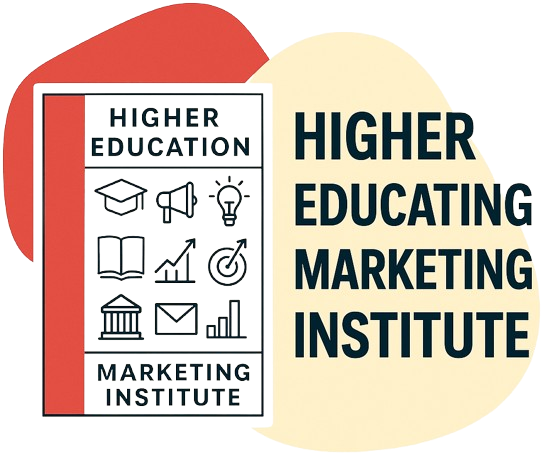Higher Education Marketing Plan Summary
The higher education marketing landscape is rapidly evolving, driven by trends in digitization, personalization, and data-driven strategies. To remain competitive, institutions must integrate digital tools with traditional methods, focusing on clear goals and alignment with modern student expectations.
Key priorities include leveraging AI, data analytics, social media, and immersive technologies like VR, alongside personalized and targeted marketing tactics. Forward-thinking approaches, such as influencer partnerships and VR campus tours, are becoming essential to attract and engage prospective students effectively.
Need help building your Higher Education Marketing Plan? Visit Search Influence for expert resources!
Table of Contents
- Higher Education Marketing Plan Summary
- Top Marketing Strategies for Higher Education
- Unique Higher Ed Marketing Ideas
- Education Marketing Trends
- Key Trends to Watch in the Education Market in 2025
- Three Higher Education Marketing Trend Predictions for 2025
- Higher Education Marketing Strategy: 3 Schools Using Future Trends to Get Ahead
- Applying the Four P’s of Marketing in Higher Education
- Education Marketing: Strategies, Benefits, and Examples
- 7 Steps to a Successful Marketing Plan
- Winning Higher Education Marketing Strategies
- 8 Higher Ed Digital Marketing Tactics & Trends for 2024
- The Ultimate Higher Education Marketing Strategy Guide by Dotdigital
- How to Market Your Higher Education Programs to Prospective Students
- Higher Education Marketing: Getting Started by Will Scott
- Higher Education Marketing Strategy
- 10 Components of an Education Marketing Plan (Part 1)
- Higher Education Marketing Plan Development: Agency Best Practices
- Start the New Year Right: A Step-by-Step Guide to Refreshing Your Education Marketing Plan for 2025
- Synopsis for ClickUp’s University Marketing Plan Template
- Higher Education Marketing Plan Release
- Timing Your Enrollment Marketing Plan Campaigns
- Ultimate Higher Ed Marketing Plan
- How to Develop a Successful Education Marketing Plan
- Private University Marketing Plan Template Overview
- 5 Easy Steps to a Marketing Strategic Plan
Top Marketing Strategies for Higher Education
- Personalization – Tailor content and interactions to boost enrollment and retention.
- AI & Automation – Streamline marketing and improve customer service.
- Data Analytics – Understand trends, optimize strategies, and meet student needs.
- Social Media – Engage students directly and effectively.
- Digital Tools – Empower marketing teams with limited resources.
- Influencer Marketing – Expand outreach through influential personalities.
- VR & AR – Offer immersive tours and experiences.
- Targeted Campaigns – Segment audiences for precise messaging.
- Content Marketing – Build trust through educational content.
- Online Education Marketing – Tailor strategies to growing demand.
Unique Higher Ed Marketing Ideas
- Blockchain – Secure, transparent data management.
- Programmatic Advertising – Behavior-driven ad targeting.
- SEO – Boost online visibility.
- Storytelling – Forge emotional connections through narratives.
- YouTube Influencers – Reach audiences with video content (e.g., Tulane University).
- CRM Systems – Optimize data management and student outreach.
- Integrated Campaigns – Blend online and offline efforts.
- Consistent Messaging – Strengthen brand identity across platforms.
- Buyer Personas – Focus on deeply understanding your audience.
- Cyclical Resource Allocation – Reassess strategies periodically.
Stay ahead of trends and start crafting your winning strategy today!
Education Marketing Trends

This webpage discusses the latest trends in education marketing, including:
Social Media
Automation
Big Data
Chatbots
Voice Search
Influencer Marketing
Virtual Reality
Artificial Intelligence
Blockchain
Social Media
Engaging prospective students through social media platforms offers direct communication with students and acts as a cost-effective promotional tool. With the rise of social networks such as LinkedIn, Facebook, and Instagram, universities can create a connection which can aid their marketing efforts.
Automation
The automation of marketing activities can make them more effective and time-efficient. Examples include email and SMS marketing campaigns, which can be automated to reach target groups at the optimal time.
Big Data
Big data allows for better decision-making based on user behaviors, preferences, and feedback. This can help educational institutions tailor their marketing strategies to meet potential students’ needs.
Chatbots
Chatbots can provide instant customer support, creating an effective, personalized system for interaction.
Voice Search
With the advancement of technology, voice search has become more prevalent, influencing how SEO works in education marketing.
Influencer Marketing
Bringing on industry influencers to advocate for your institution can increase its credibility and broaden its reach.
Virtual Reality
Virtual campus tours using VR technology provide a more interactive and immersive experience for student recruitment, attracting prospective students.
Artificial Intelligence
AI presents opportunities for marketing in the education industry, from content creation to customer interactions.
Blockchain
Although relatively new in education marketing, blockchain could revolutionize data management and verification, providing a transparent, secure system.
Background resources: None mentioned.
Unique positions: The webpage highlights the use of blockchain technology in education marketing, a relatively new concept in the industry.
Summary and takeaways: The education sector is increasingly applying current digital marketing trends to engage with potential students and influence their decisions. These trends range from traditional social media usage and automation to more recent innovations such as chatbots, AI, VR, and blockchain. The sector must keep up-to-date with these trends for effective communication and promotion.
https://marketinglad.io/education-marketing-trends
Explore latest #EducationMarketing trends: #SocialMedia #Automation #BigData #Chatbots #VoiceSearch #InfluencerMarketing #VR #AI #Blockchain. 📚🌐🤖🧠🔗
Tweet
Key Trends to Watch in the Education Market in 2025

This webpage, published in Market Brief by EdWeek, discusses emerging trends expected in the education market by 2025. The article provides an analysis based on diverse input from five education market experts.
A. The Experts
Emily Freitag – Co-founder and CEO, Instruction Partners
John Katzman – Founder and CEO, Noodle
Curt Allen – Chairman and CEO, Agilix Labs
Joe Morgan – CEO, Noodle Partners
Andrew Clark – Co-founder and CEO, Zovio (formerly Bridgepoint Education)
B. Key Trends
The following are the five major trends identified by the experts:
Greater Personalization in Learning
Students’ needs are predicted to be met through more personalized learning experiences.
Differentiated instruction and materials will aim to support diverse student skill sets and learning styles.
Growing Influence of Artificial Intelligence (AI)
AI is anticipated to continue disrupting traditional education methods.
AI integration may range from personalized tutoring/mentoring to grading assignments and tailoring curriculum.
Increased Demand for Skills Training
There will likely be a shift towards more specific, job-oriented skills training.
This could involve industry-sponsored training modules and courses that align with marketable skills.
Digital Tools Dominating Classrooms
Digital resources and tools will likely become even more prominent.
The use of online platforms, learning management systems, and education technology is expected to grow.
Heightened Focus on Competency-Based Education
Competency-based education will likely receive more focus, with students progressing through curriculum at their own pace, based on mastery.
C. Summary and Takeaways
Employing technology for personalized learning, integrating AI in teaching methods, focusing on skills training, using digital tools in classrooms, and adopting competency-based education are predicted to be major trends in the education market by 2025. These trends highlight how technology is predicted to reshape the field of education, emphasizing a move towards personalized and competency-based learning.
Education 2025 trends📚: Personalized learning, 🤖 AI’s rise, 🛠️ skills training, 💻 digital tools, & 🎯 competency-based ed. #EdTech #FutureEducation
Tweet
Three Higher Education Marketing Trend Predictions for 2025

This article, written by Travis Marsh for InsideHigherEd, looks forward to 2025 and examines potential trends in the realm of higher education marketing. The author postulates that three major shifts will shape the landscape: the population boom of college-age students, the rise of online education, and increasingly sophisticated data analytics platforms.
Major Trends
Population Growth of College-Age Students
Marsh discusses the expected dramatic increase in college-age students over the next 10 years. He predicts that marketing towards this demographic will require new, innovative strategies, largely driven by data analytics. Targeted marketing strategies will leverage consumption patterns to better engage prospective students.
Sources Cited: WICHE’s Knocking at the College Door
Growth of Online Education
Without specifying data backing, Marsh also speculates about the continued growth of online education. The broadening access to versatile online programs and lessons will lead to different marketing tactics, such as combining offline and online campaigns.
Advanced Data Analytics Tools
Again, Marsh does not ground this prediction in specific data, but suggests that more data analytics tools will be used in higher education marketing. This will enable universities to understand student behaviors and preferences in more detail, helping create more precise and effective promotional strategies.
Summary and Takeaways
Marsh ends the article without a formal conclusion, but the implications of his predictions are clear. Higher education marketing is poised to evolve significantly in the future due to expected population growth among college-age students, the rise of online education, and the use of advanced data analytics tools in marketing strategies. To stay relevant, organizations should be prepared to adapt and embrace these changes.
The article takes a unique stance by focusing not just on the trends that will shape higher education marketing, but also on how institutions can leverage these trends to enhance their marketing strategies.
Sources Cited: None (WICHE’s Knocking at the College Door is a previous publication by the author)
2025 higher ed marketing: 🎓💻 More college-age students, online ed growth, & 📊 data analytics. Stay ahead! #HigherEdMarketing #EducationTrends
Tweet
Higher Education Marketing Strategy: 3 Schools Using Future Trends to Get Ahead
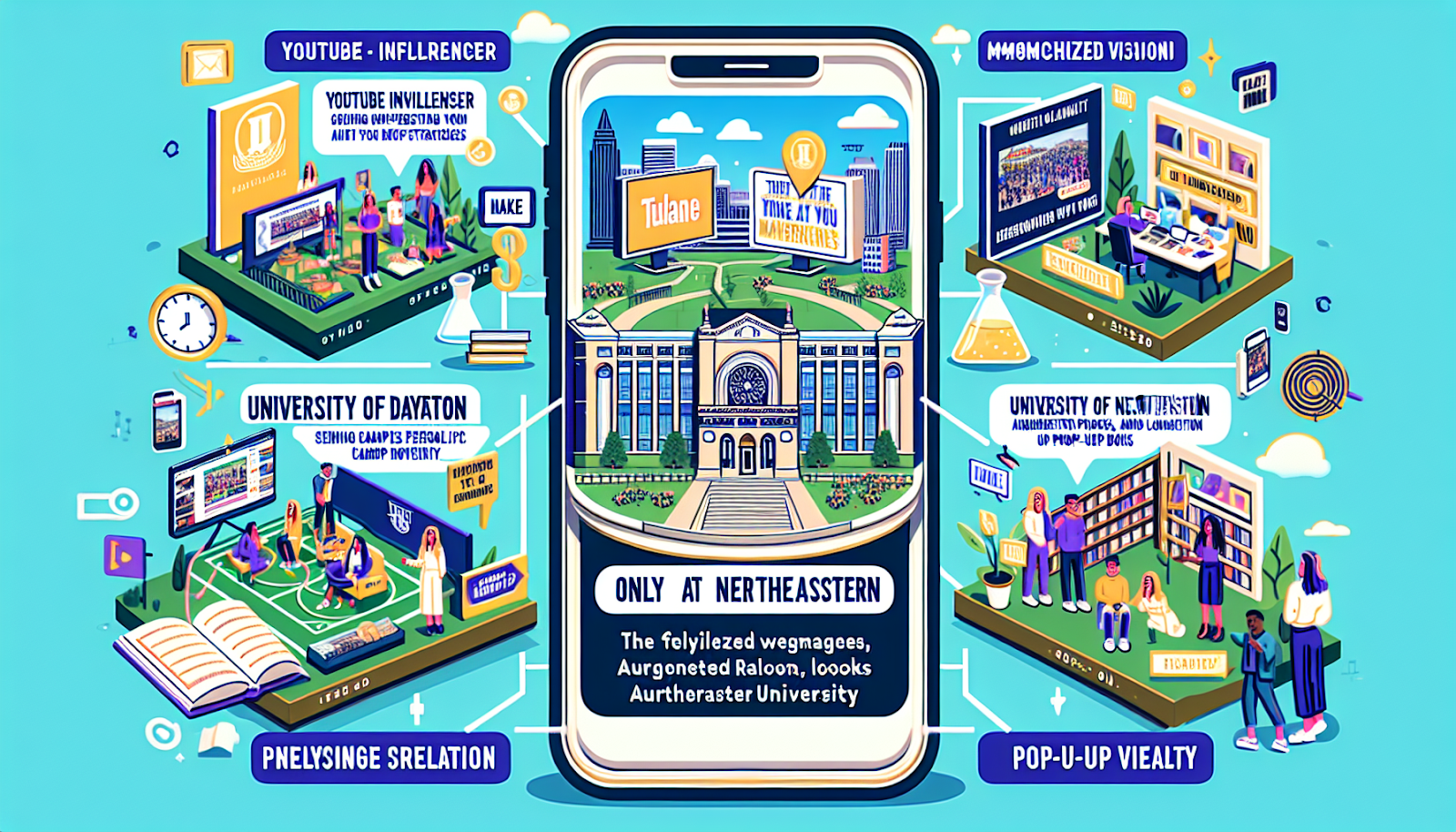
The webpage explains the concept of higher education marketing strategies and provides examples of three schools that have used these innovative strategies effectively.
Background
There is an increased competition among colleges and universities to attract and retain students. Consequently, these institutions are looking towards marketing strategies for driving student engagement and enhancing college enrollment.
Unique or Noteworthy Position
Instead of using the traditional education marketing methods that focus on the benefits of receiving an education, educational institutions are now leveraging a comprehensive university marketing strategy that revolves around the needs and expectations of prospective students and their parents.
Examples of Higher Education Marketing Strategies
The webpage cites three colleges that have adopted innovative higher education marketing strategies:
Tulane University: Used YouTube influencers to make prospective students aware of the lifestyle and academic environment they can expect at their college.
University of Dayton: Implemented a strategy of innovative and personalized communication. They use personalized videos, augmented reality, and pop-up view books to help students visualize their life at the University.
Northeastern University: Introduced The “Only at Northeastern” campaign. The campaign has a personalized student version, a Parent version and an all-in-one version, touting their unique programs, location, and co-op experiences.
Higher Education Marketing Future Trends
The article also discusses future trends in college marketing that universities need to adopt to stay competitive, including:
Omnichannel marketing: By aligning content and design across all platforms, universities can create a seamless and integrated experience for prospective students.
Personalization: Future students are more likely to engage with personalized communication. Schools are using student data to customize their marketing messages.
Influencer marketing: Colleges and universities are harnessing student and alumni networks as a way to market to prospective students.
Virtual reality and augmented reality: These technologies provide an immersive experience to prospective students who are unable to visit campuses in person.
Summary and Takeaways
With intensified competition among higher education establishments to attract and retain students, colleges and universities will have to redefine their marketing strategies to adapt to current and future marketing trends. Techniques such as Omnichannel marketing, personalization, influencer marketing, and virtual reality are likely to become increasingly commonplace within higher education marketing. As noted from the three examples, institutions that engage innovatively with these trends may gain an advantage in attracting and retaining students.
References: None cited.
https://moderncampus.com/blog/higher-education-marketing.html
See how Tulane, Dayton, & Northeastern use cutting-edge marketing for education. 🎓📚 #HigherEd #EducationMarketing
Tweet
Applying the Four P’s of Marketing in Higher Education

This article from Academic Impressions discusses the relevance of the traditional ‘Four P’s of marketing’ (Product, Price, Promotion, and Place) in higher education. It highlights the ways these principles can support institutions as they communicate their unique offerings to prospective students and families in the current market landscape.
Product:
In higher education, the product is a complex bundle of experiences, education, opportunities, and outcomes.
Institutions must effectively communicate the unique attributes and benefits of their offerings, linking both tangible and intangible elements.
Amplifying the difference between general knowledge and specific skills could be advantageous.
Price:
Price is more than tuition; it also refers to the potential financial and opportunity costs of attending an institution.
Transparency about affordability and value is key in attracting and retaining students.
Providing a clear and complete picture of the investment required and the returns to be expected is essential.
Promotion:
Institutions must carefully strategize promotional activities, considering their audience and their information consumption habits.
The medium matters – determine channels based on where your audience is likely to engage.
Consistent messaging across different platforms is important for creating an integrated brand identity.
Place:
The physical campus is indispensable in higher education marketing.
However, the concept of place also extends to virtual spaces.
Striking a balance between online and in-person experiences is key to meet diverse audience needs.
The article emphasizes that grounding marketing strategies in these classic principles can help higher education institutions effectively communicate their value proposition in a competitive and evolving market environment.
Summary and Takeaways:
– The Four P’s of Marketing are still relevant in higher education.
– They represent a robust framework, guiding institutions in their marketing efforts.
– By understanding and applying Product, Price, Promotion, and Place, institutions can attract, engage, and retain students in a more strategic and effective manner.
The article does not cite any additional resources.
https://www.academicimpressions.com/applying-four-ps-marketing-higher-education/
Applying the 4P’s in higher ed: Product, Price, Promotion & Place shape how institutions convey value. 🎓 #HigherEd #MarketingStrategy
Tweet
Education Marketing: Strategies, Benefits, and Examples
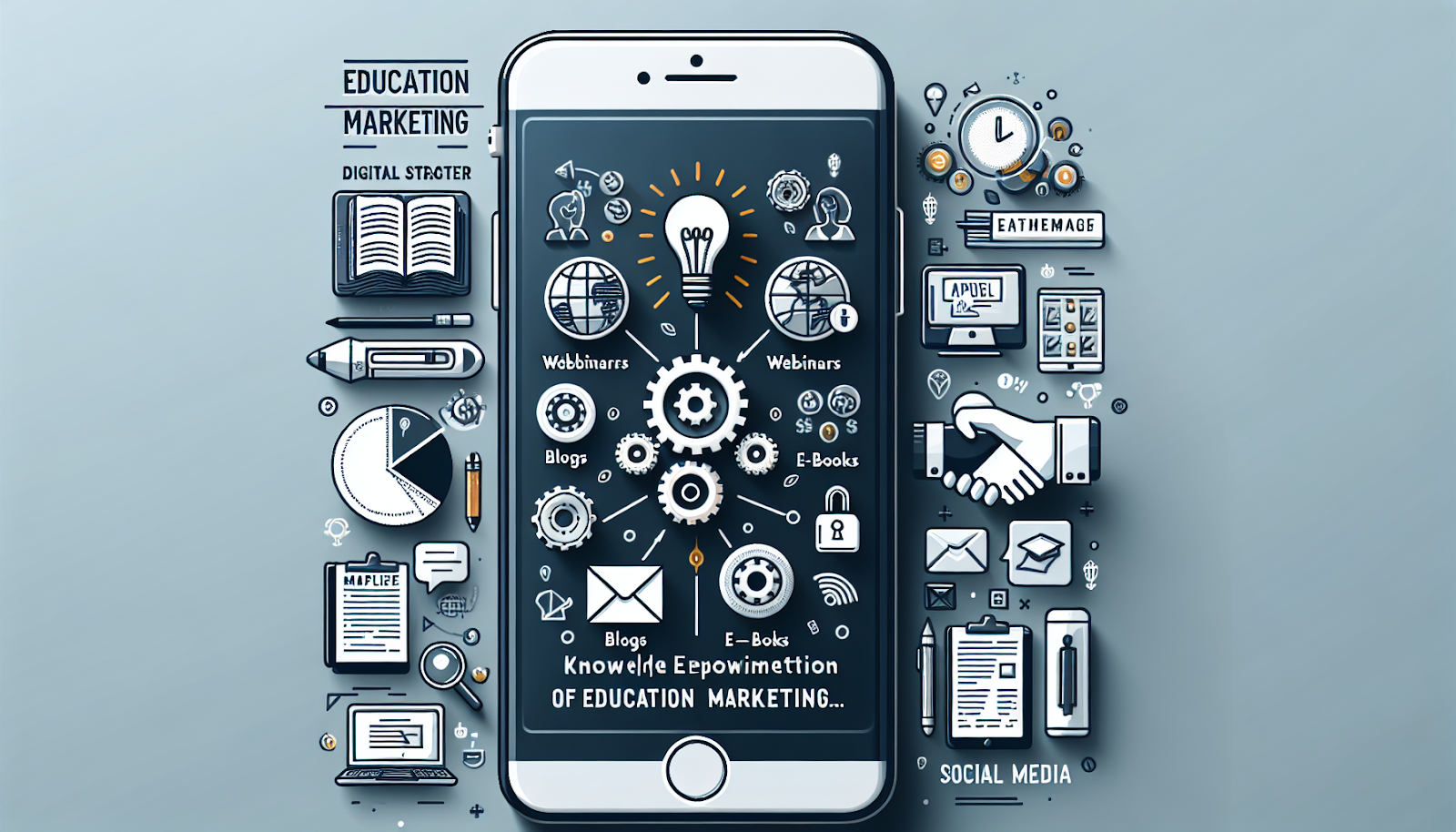
The webpage from Hubspot discusses the concept of education marketing – the strategy of not just promoting products or services, but imparting valuable knowledge to customers. It emphasizes the importance of education marketing, outlines various strategies, and gives a couple of examples.
What is Education Marketing?
Education marketing isn’t just about selling your product or service; it’s about teaching people something they didn’t know before.
It guides potential customers through the buyer’s journey by providing valuable, informative content.
This strategy is based on the principle that well-educated consumers make better purchasing decisions.
The Importance of Education Marketing
The webpage cites a study from Forrester, stating only 3% of B2B buyers trust vendors. So, if businesses want to gain customer trust, they need to offer something beyond promotional content – that is education.
Educational content helps businesses establish themselves as leaders in their fields, build brand loyalty, attract potential customers, and nurture existing relationships.
Strategies for Education Marketing
Blogs: Blogs are a platform for businesses to share insights and give detailed explanations.
Webinars: They offer live, interactive sessions where businesses can educate customers and engage them simultaneously.
E-books: They provide comprehensive information on specific topics related to the business’s product or service.
Social Media: Among all the platforms, YouTube is great for visual learners where businesses can create instructional videos.
Email Marketing: Businesses can keep customers informed about the latest industry trends or updates.
Examples of Education Marketing
Moz and their popular guide on SEO – “The Beginner’s Guide to SEO.”
Cleveland Clinic’s Health Essentials blog offers valuable health and wellness tips.
Takeaways from the Webpage
Education marketing is about empowering consumers with knowledge.
It helps businesses establish themselves as thought leaders in their industries, build brand loyalty, and maintain long-term customer relationships.
Different strategies can be employed to implement education marketing, including blogs, webinars, e-books, email marketing, and social media.
Companies like Moz and Cleveland Clinic have successfully used education marketing to their advantage.
The webpage does not cite any outside resources aside from the Forrester study. Also, the page doesn’t seem to take any unique or noteworthy positions.
The main takeaway is the importance of education marketing in building trust and nurturing customer relationships with informative and valuable content.
https://blog.hubspot.com/marketing/education-marketing
Education marketing empowers customers to make smart choices, building trust & loyalty. 🚀 See Moz & Cleveland Clinic’s success! 🎓💼 #EducationMarketing
Tweet
7 Steps to a Successful Marketing Plan
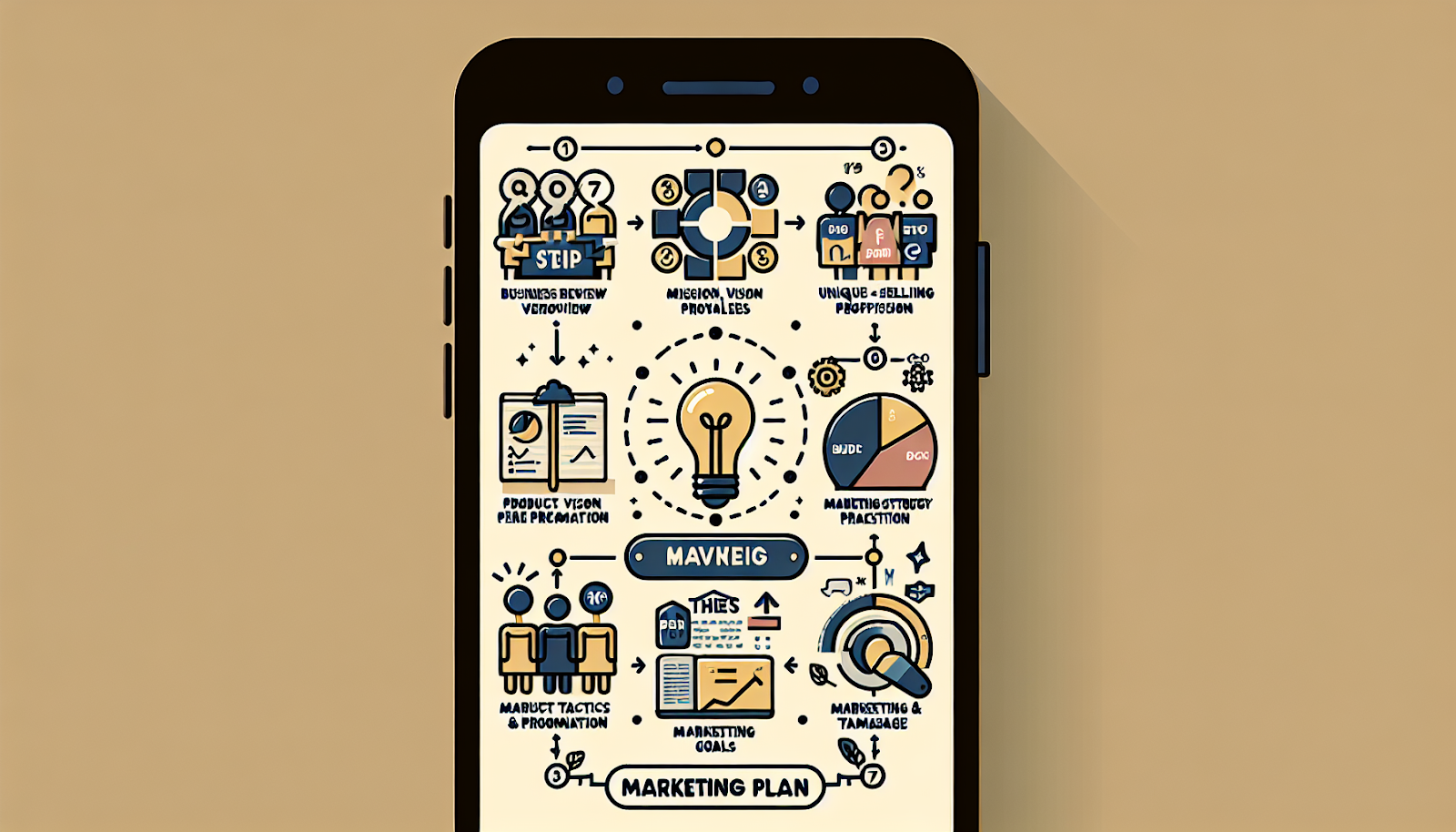
The blog post by Pulse Marketing Agency provides a step-by-step guide for creating an effective marketing plan. The guide is divided into seven steps and offers insights into the practices and principles of successful marketing strategy formulation.
Introduction The author emphasizes the importance of a well-planned approach in marketing. The article stresses on defining clear objectives which are achievable, measurable, realistic, and time-bound.
Step 1: Business Review The first step to creating a marketing plan is a thorough review of the business. This involves an understanding of the company’s mission, vision, values, strengths, weaknesses, opportunities, and threats (SWOT).
Step 2: Target Market Identifying the target market is step two. Knowing the intended audience helps in tailoring the company’s marketing strategy to their specific needs, preferences, and behaviors.
Step 3: Unique Selling Proposition The third step is to define the company’s unique selling proposition (USP). This helps in distinguishing a business from its competitors and attracting its target customers.
Step 4: Marketing Strategy The fourth step is formulating the marketing strategy. This involves detailing the marketing mix, also known as the 4 Ps – product, price, place and promotion.
Step 5: Budget The fifth step involves setting a marketing budget. The marketing budget is configured according to the company’s revenue percentage.
Step 6: Marketing Goals The sixth step is setting the marketing goals. Marketing goals need to be specific and particular, to effectively measure success.
Step 7: Marketing Tactics & Message The last step involves planning the marketing tactics and messages. This includes the specific actions to be taken to reach marketing goals.
Takeaways from the article: Creating a successful marketing plan requires a solid understanding of the business’s mission, its SWOT analysis, the target market, the company’s USP, the marketing strategy, the budget, the goals, and the marketing tactics. The effective alignment of these elements results in a well-strategized marketing plan. The author doesn’t list any unique or noteworthy positions.
No external resources or background information is cited in the article. The information is presented from the author’s professional knowledge and expertise in the field of marketing.
https://pulsemarketingagency.com/blog/7-steps-to-a-successful-marketing-plan/
Master marketing with Pulse Marketing’s 7-step guide! 🎯 Know your business & audience for success. 💼 #MarketingStrategy
Tweet
Winning Higher Education Marketing Strategies

This webpage discusses the importance of creating a strategic marketing plan for higher education institutions. It lists and explains four key strategies that can make the marketing plan of a higher education institution successful.
Strategy 1: Nurturing a Brand Promise
The first strategy revolves around understanding what makes a university unique and ensuring it shines through marketing efforts. A university’s unique promise is what differentiates it from other institutions, making it a desirable choice for prospective students.
Strategy 2: Utilizing SEO
SEO or Search Engine Optimization is instrumental in making a university’s website reach prospective students when they search for options. The university website should focus on specific key terms that a potential student might search and optimize content for the same.
Strategy 3: Prioritizing User Experience (UX)
User experience includes a potential student’s experience on the website, starting from the layout and ease of navigation to the speed of the website. A good user experience can leave a lasting impression and determine whether a potential student will consider the institution for further education.
Strategy 4: Leveraging Paid Advertising
Paid advertising, including digital platforms like Google Adwords and social media advertising on platforms like Facebook and Instagram, can reach a wide audience. The advertisement can target prospective students based on their interests, previous searches, and demographics.
Effect of Marketing on Enrollment Rates
The article also states that good marketing strategies can aid in increasing enrollment rates. By reaching the right audience and effectively communicating with them, universities can attract more students. Therefore, it’s beneficial for universities to invest in strategic marketing endeavors.
Conclusion
The marketing strategies discussed in the article can not just help universities reach out to more prospective students, but also ensure they stand out from the crowd. Understanding and implementing these strategies can go a long way in making a university’s marketing efforts successful.
https://www.searchinfluence.com/blog/winning-higher-education-marketing-strategies/
4️⃣ winning higher ed marketing strategies⚡: Brand Promise🎓, SEO🔍, UX🖥, and Paid Ads📱. Boost enrollment 📈! #HigherEd #MarketingStrategies
Tweet
8 Higher Ed Digital Marketing Tactics & Trends for 2024

This article, published on oho.com, discusses the eight anticipated trends and strategies in the field of higher education digital marketing for the year 2024.
Integrated Student Experience
As higher education institutions digitalize their operations, an integrated student experience across multiple online platforms will increase in importance. This includes the application process, class registration, financial matters, and attending virtual classes.
Personalized Digital Marketing
The personalization of digital marketing, which includes addressing the individual needs and interests of prospective students, will continue to be a trend. Using tools like virtual tours, personalized emails, and interactive content will offer a tailored experience for students.
Artificial Intelligence and Automation
Adoption of artificial intelligence (AI) and automation technologies is predicted to increase. This includes chatbots for instant student support and the automation of administrative tasks.
Data-Driven Decisions
Higher education institutions will increasingly use data analytics to make strategic decisions. This includes program offerings, student retention, and alumni engagement. Effectively managing and leveraging data will be vital for marketing success.
Increased Use of Video Content
Video content will continue to be a preferred method of engagement. Institutions will make greater use of video for instructional, promotional, and engagement purposes.
Virtual Reality & Augmented Reality
Virtual and augmented reality technologies will be increasingly adopted by higher education institutions. These technologies offer an immersive experience for students, especially in remote teaching and learning scenarios.
Mobile-First Design
With the global increase in smartphone use, a mobile-first approach to digital design will grow in importance. This involves optimizing websites and online interfaces for mobile use.
Greater Use of Social Media
Social media platforms will continue to be an essential tool for student engagement and communication. These platforms offer the opportunity for direct interaction and community building.
In summary, higher education institutions will likely need to adapt to these ongoing trends in digital marketing to attract and retain students. Emphasis will be on improving the digital student experience, personalized marketing, the use of AI and automation, data analytics, the use of video content, virtual and augmented reality technologies, a mobile-first design approach, and the increased use of social media.
https://www.oho.com/blog/8-higher-ed-digital-marketing-tactics-trends-2024
Watch 2024 Higher Ed trends: Integrated student experience, personalized marketing, & AI/automation will lead. 🎓📲 #HigherEducation #DigitalMarketing
Tweet
The Ultimate Higher Education Marketing Strategy Guide by Dotdigital
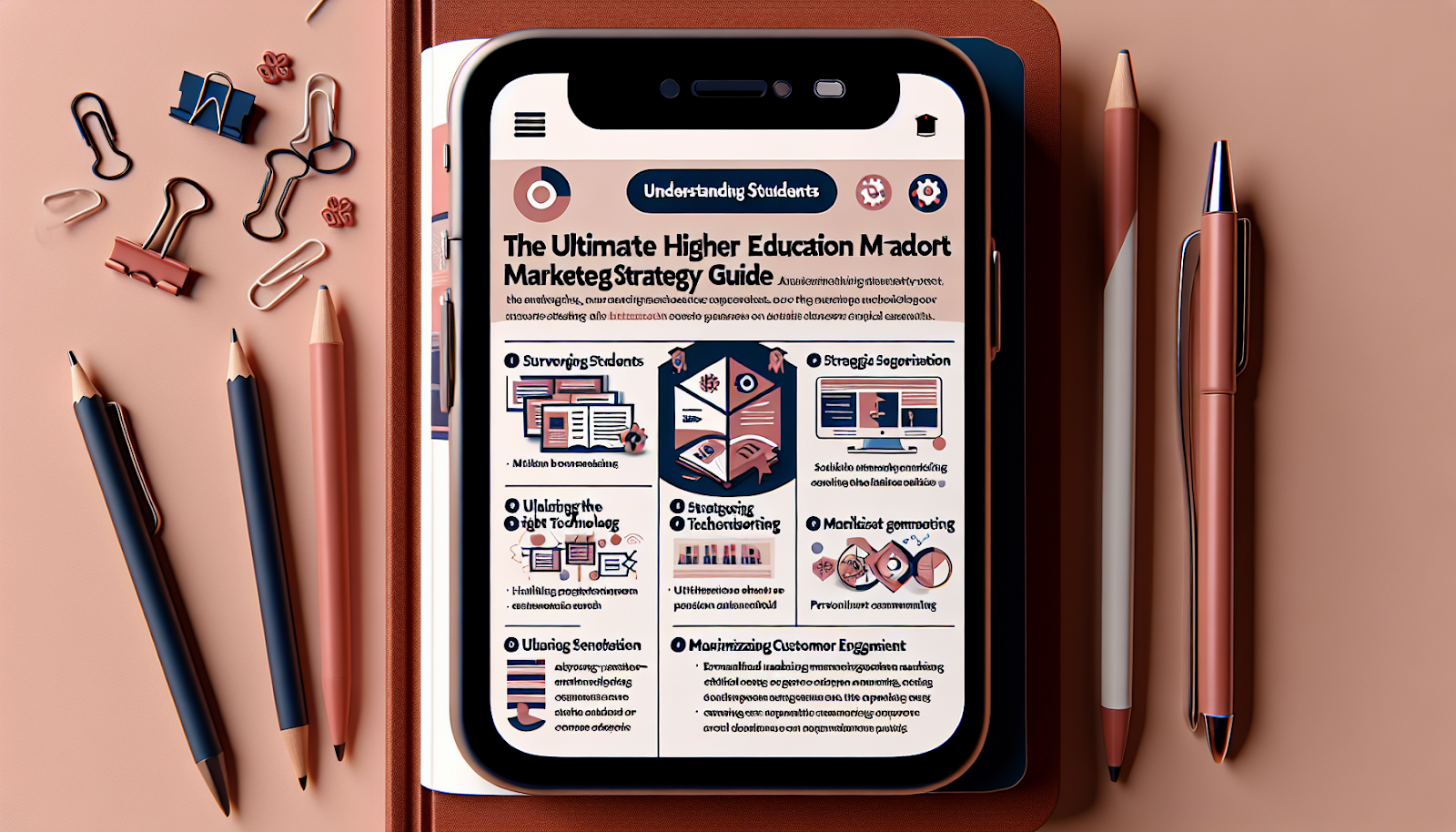
This webpage provides a detailed guide on effective marketing strategies for higher education institutions. It offers insights, strategies and practical recommendations in areas such as understanding students, strategic segmentation, technology, personalization, and customer engagement.
1 Understanding Students
The page emphasizes the need to understand the needs, preferences, and goals of current and future students to create a relevant and effective marketing strategy.
It recommends using surveys, market research, and ongoing data analytics to gain in-depth understanding of students.
2 Strategic Segmentation
The guide highlights the importance of segmentation in delivering personalized marketing messages to students.
Schools are advised to segment their audience based on factors such as demographic data, geographical location, course of interest, and online behavior.
3 Utilizing the Right Technology
Institutions are urged to leverage on technology in their marketing activities. This includes the use of customer relationship management (CRM) systems to manage and analyze data.
Email marketing, social media, and automation are also recommended as part of the high-tech marketing mix for higher education institutions.
4 Personalization
The page encourages educational institutions to tailor their communications and services to meet the unique needs of each student.
This approach fosters a more personalized experience, cultivating a deeper rapport between the institution and its students.
5 Maximizing Customer Engagement
Lastly, the guide insists on the value of maintaining a high level of student engagement to secure enrollment and retention. This can be achieved through relevant and timely communications, active social media presence, and provision of value-added services.
The webpage does not cite any background resources.
Summary
The guide provides insightful, practical strategies in the following areas: understanding the students, segmentation, technology utilization, personalization, and customer engagement.
It suggests that institutions who adopt these strategies can effectively boost enrollment and retention rates by delivering well-curated, personalized experiences to their students.
The article implies that in an increasingly competitive sector, higher education institutions need to leverage on data, technology, and personalized communication to stand out from the crowd.
https://dotdigital.com/education-marketing/the-ultimate-higher-education-marketing-strategy-guide
Boost enrollment & retention with @dotdigital’s #HigherEd marketing guide! Insights on students, segmentation, tech, & engagement. 🎓📊 #EdTech #MarketingStrategy
Tweet
How to Market Your Higher Education Programs to Prospective Students

This webpage by UPCEA (University Professional and Continuing Education Association) provides valuable insights on marketing strategies for higher education programs. This content is informed by a study conducted by Ruffalo Noel Levitz, Othot, and UPCEA.
Key Areas Explored
Current stats for marketing methods in the higher education sector
Ruffalo Noel Levitz in conjunction with Othot and UPCEA conducted a study on higher ed marketing in 2020.
The results show an increased focus on digital marketing strategies.
Five suggested tactics for effective marketing of higher education programs
Targeting.
Personalization.
Consistency.
Authenticity.
Using data.
Details on the Suggested Tactics
Targeting
It suggests that schools have the best chance of engaging students when they use targeting to focus on specific student populations.
This approach could include looking at students’ preferred communication channels and then targeting those channels with appropriate advertising materials.
Personalization
To better meet the unique needs of each student, higher ed marketers should consider personalizing their interactions.
Personalization could be achieved via tailored email campaigns, for instance.
Consistency
Clear and consistent messaging can help improve brand recognition among students.
Authenticity
Schools should consider making sure their advertising materials reflect the actual experience they offer their students.
Using data
Leveraging data from various sources can help higher ed marketers understand their audience better, thus optimizing their marketing strategies.
Summary and Key Takeaways
Today’s higher education sector is increasingly looking towards digital marketing strategies.
Five essential tactics to consider for marketing include targeting, personalization, consistency, authenticity, and the use of data.
It’s recommended to focus on these elements as a way for higher ed institutions to improve outreach effectiveness and to better engage with potential students.
https://upcea.edu/how-to-market-your-higher-education-programs-to-prospective-students/
Explore digital marketing for higher ed with UPCEA! Tactics: targeting, personalization, authenticity, & data. 🎯💻📚 #HigherEd #EducationMarketing #UPCEA
Tweet
Higher Education Marketing: Getting Started by Will Scott

This webpage by Will Scott, offers insight into the process of marketing in higher education. The author discusses some key points to understand when starting off in this specific marketing niche. The webpage cites no background resources. It does not present any unique or noteworthy positions.
Key Elements of Higher Education Marketing
Understanding the Goal: Need to understand the primary objective, whether it’s increasing enrolment, improving the university’s reputation, or attracting more international students.
Understanding the Target Audience: Marketing efforts must be directed toward the right audience – prospective students, alumni, faculty, or financial donors.
Format and Medium: Understanding the most effective format and medium for reaching the target audience, with an emphasis on digital content and social media.
Factors Influencing Market Trends in Higher Education
Tuition fees, financial stress, and funding cuts
The importance of ‘Brand’ in higher education
Growth of remote and online learning
Increasingly competitive landscape and the need for a unique selling proposition
Approach to Higher Education Marketing
Utilizing Social Media: LinkedIn, Facebook, and Instagram can be particularly effective platforms for reaching prospective students.
Website Development: The university website must be high-quality, user-friendly, and mobile responsive.
Use of SEO and PPC: The use of search engine optimization (SEO) and pay-per-click (PPC) advertising is suggested to improve online visibility.
Partnerships and Collaborations: Collaboration with various high profile events, organizations, or personalities can help to increase visibility and reputation.
Summary and Takeaways
Higher education marketing involves understanding the specific goals and target audience of the university or institution. The trend is increasingly moving towards remote and online learning, making digital content and social media platforms vital for effective marketing. A high-quality, user-friendly university website, along with partnerships/collaborations can also play a crucial role in enhancing visibility and reputation. SEO and PPC are suggested methods for improving online visibility.
https://www.linkedin.com/pulse/higher-education-marketing-getting-started-will-scott-beevc
Starting in #HigherEducationMarketing? Know your goal, audience, & format. Trends show online learning growth & a strong brand. 💼🎓 #DigitalMarketing
Tweet
Higher Education Marketing Strategy
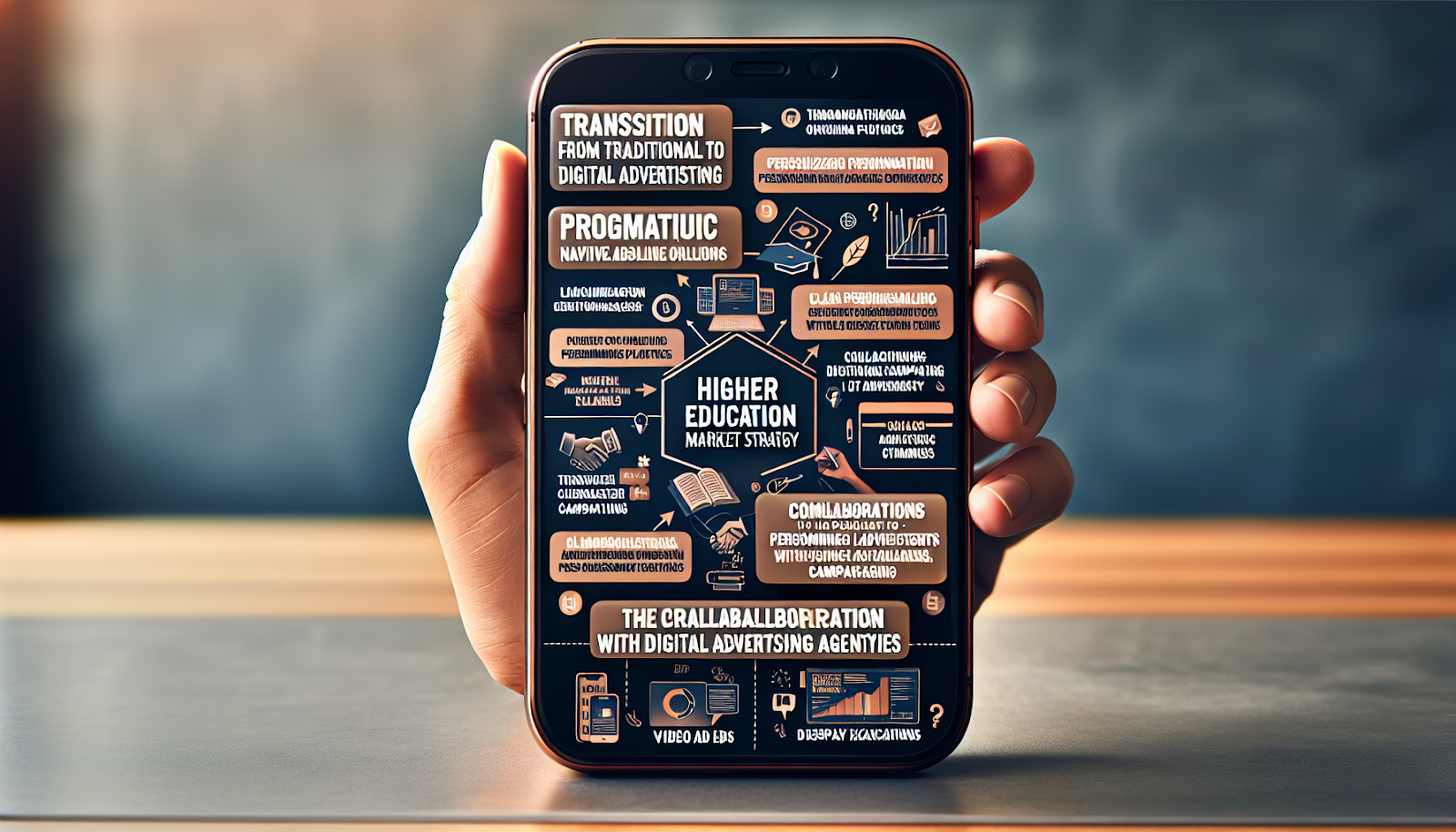
The webpage discusses the shift in higher education marketing and provides tips for institutions to stay relevant.
I. The Changing Landscape of Higher Education Marketing
Traditional forms of marketing are being replaced by digital advertising strategies.
Prospective students are now found online, consuming content across a variety of platforms.
II. Leveraging Programmatic Advertising
The webpage suggests programmatic advertising as a key strategy.
Programmatic advertising allows targeting of ads based on user behavior and interests, increasing engagement and conversion rates.
Different form of programmatics like Video Ads, Native Ads and Display Ads are mentioned.
III. Importance of Data
Data plays a critical role in marketing, helping institutions to understand their audience and adapt their approach accordingly.
It can be used to inform the creation of personalized content and messaging, as well as to analyze the effectiveness of campaigns.
IV. Measuring Success
Setting clear goals and KPIs (Key Performance Indicators) and measuring them regularly is important to decide on the success of a marketing campaign.
V. Partnerships
The webpage highlights the potential benefits of partnering with a digital advertising agency to leverage their expertise and reach.
VI. Challenges and Solutions
The piece mentions challenges faced by institutions – declining enrolment rates, varied learner expectations, the emergence of several online programs.
Suggested solutions include utilizing a data-driven approach, using programmatic advertising to engage the digital audience, continuously reviewing campaign KPIs, and exploring partnerships with digital advertising agencies.
Summary and Takeaways
There’s a shift in traditional higher education marketing strategy, and digital advertising strategies are being increasingly used.
Programmatic advertising can be beneficial due to its targeted, data-driven nature.
Data is valuable in creating personalized content and understanding audience behavior.
Clear goals and measurable KPIs are essential to analyze the success of marketing campaigns.
Partnership with digital advertising agencies can provide expertise and broaden reach.
Institutions face challenges such as declining enrollment and varied learner expectations, which can be addressed by these new strategies.
https://www.stackadapt.com/resources/blog/higher-education-marketing-strategy
📚 Shift to digital ads in higher ed: programmatic, data-driven content & expert partnerships. 🎯📈 #HigherEd #DigitalMarketing
Tweet
10 Components of an Education Marketing Plan (Part 1)
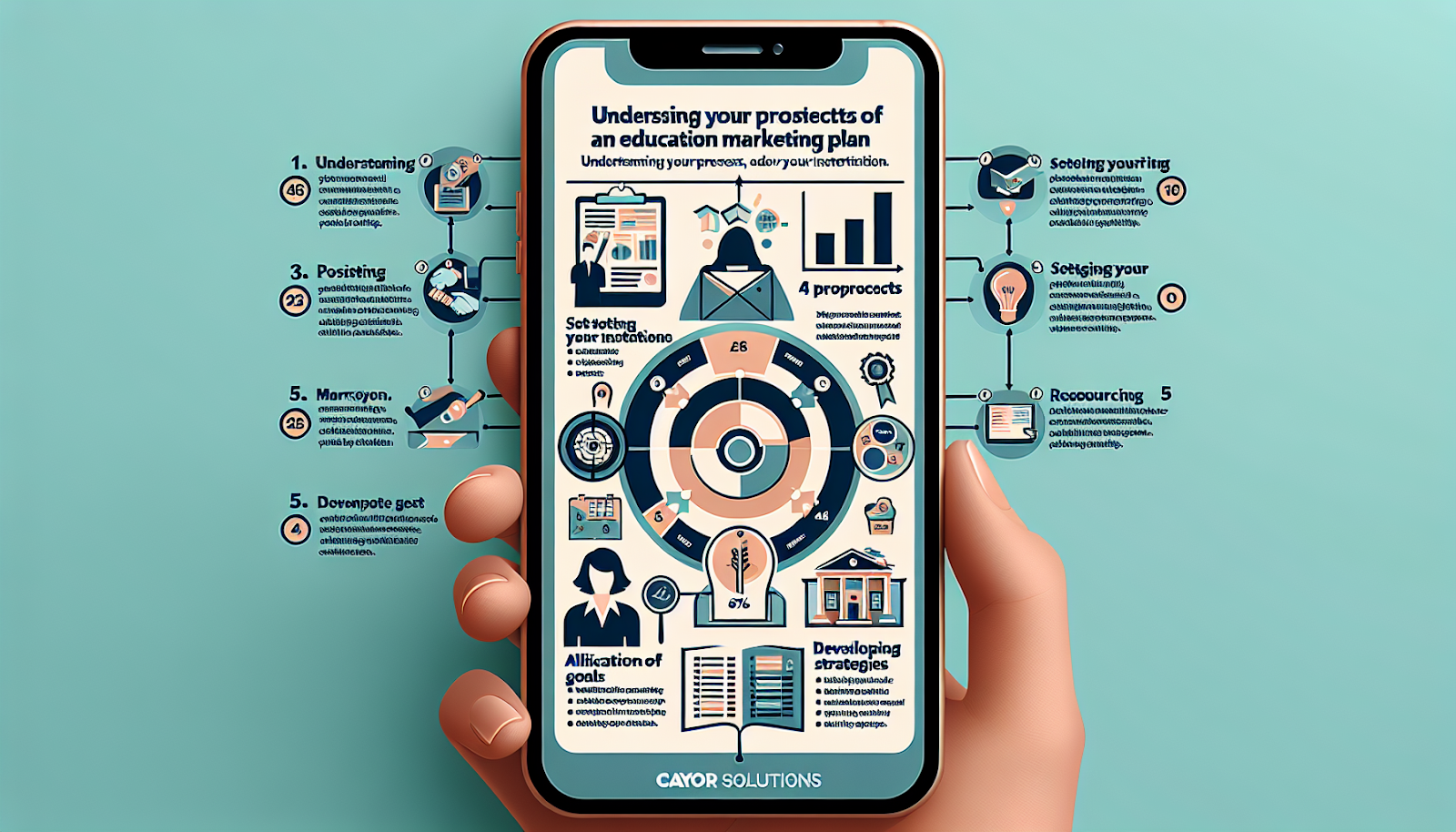
This webpage by Caylor Solutions discusses the first five out of ten components necessary for a marketing plan in the education sector.
Component 1: Understanding your Prospects
Your marketing plan should start with a thorough comprehension of your prospects. Knowing who you’re marketing to and what resonates with them is key to crafting effective marketing strategies. Here, the article cites MBO Partners which suggests creating buyer personas to better understand the target audience.
Component 2: Positioning your Institution
Positioning your institution is about clearly defining and articulating what sets your educational institution apart from others. It involves identifying your unique selling propositions and establishing a recognisable brand.
Component 3: Setting Marketing Goals
Clear, measurable marketing goals based on your overall institutional goals must be set. These could be anything from increasing student enrollment, boosting alumni donations, or expanding your institution’s brand recognition. This point emphasizes the need for SMART goals (Specific, Measurable, Achievable, Realistic, and Timely).
Component 4: Allocation of Resources
The successful execution of your marketing plan requires careful allocation of resources including talent, time, and budget. The article suggests that a cyclical approach to allocating resources could ensure more efficient use of your resources. Cyclical allocation involves reassessing and adjusting your resources periodically.
Component 5: Developing Creative Strategies
This involves developing creative strategies tailored to your institutional goals and target audience. Such strategies should be designed to resonate with your prospects and support achievement of your marketing goals.
Takeaways
Part one touches on five significant components of an education marketing plan. These include understanding your prospects, positioning your institution, setting marketing goals, resource allocation, and developing creative strategies. These elements can determine the success or failure of a marketing strategy and should therefore be given due focus.
https://www.caylor-solutions.com/10-components-education-marketing-plan-part-1
Building an education marketing plan? 1️⃣Know prospects 2️⃣Position your institution 3️⃣Set SMART goals 4️⃣Allocate resources 5️⃣Tailor strategies. Part 2 coming! #EducationMarketing
Tweet
Higher Education Marketing Plan Development: Agency Best Practices
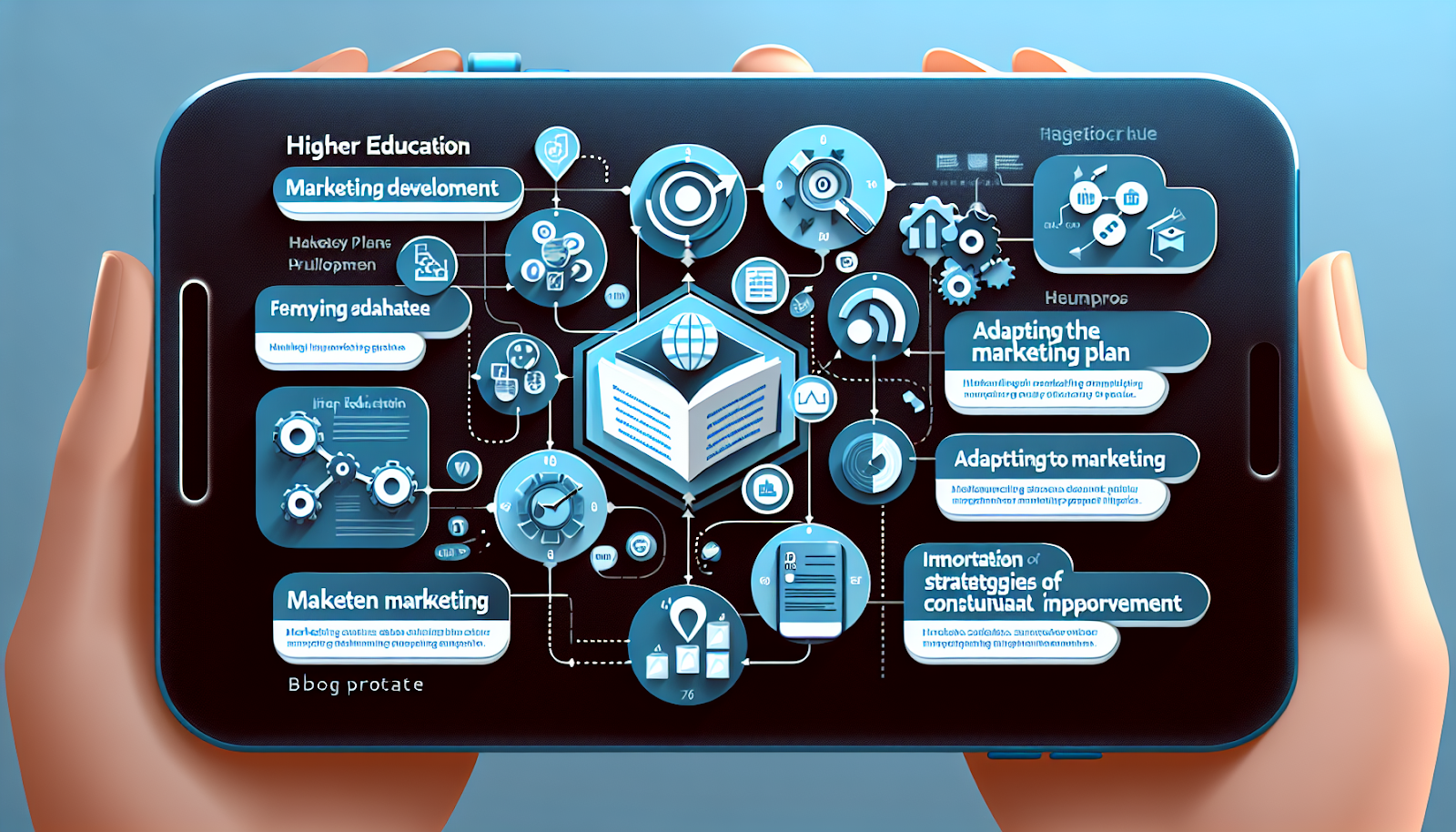
This blog post discusses the best practices that marketing agencies can employ when creating a marketing plan for higher education institutions. The authors argue that understanding the unique characteristics of the higher education sector will allow agencies to develop more effective marketing strategies for their clients.
I. Higher Education Marketing Landscape
The blog post begins with an overview of the marketing landscape for higher education.
The authors point out several key characteristics of this landscape:
The need for higher education marketing to address both student and institutional needs.
The importance of delivering a powerful brand promise.
The importance of utilizing data to target specific audience segments.
II. Formulating the Marketing Plan
Next, the authors outline the steps involved in creating a marketing plan for higher education:
Assessing the institution’s strengths and weaknesses.
Identifying the target audience and their respective needs.
Identifying the key messages that will resonate with each segment of the audience.
Choosing the appropriate channels to reach the target audience.
Determining the tactics that will be used to engage the target audience.
Setting measurable goals for the marketing campaign.
III. Adapting Marketing Strategies to Higher Education
The blog post then discusses how marketing agencies can adapt their strategies to the higher education context:
The authors argue that agencies should increase their focus on digital marketing, given the increasing importance of digital media in higher education.
They also suggest incorporating storytelling into the marketing strategy, as it allows institutions to communicate their values and create an emotional connection with prospective students.
IV. Importance of Continuous Improvement
Finally, the authors emphasize the importance of continuous improvement in marketing practices:
They suggest continually monitoring and adjusting the marketing plan based on the data collected during the campaign.
They stress the need for agencies to keep up-to-date with the latest marketing trends and technologies.
Summary
By understanding the unique characteristics of the higher education sector and formulating a marketing plan accordingly, marketing agencies can develop effective strategies for their clients.
Emphasizing digital marketing, storytelling, and continuous improvement will also contribute to the success of a marketing campaign in the higher education sector.
No background resources are mentioned in the article.
This post is unique in the way it highlights the role of storytelling in higher education marketing, and the fact that marketing agencies need to adapt strategies often used in other sectors to be effective in the education context.
Create a powerful #HigherEducation strategy: Know the sector, focus on #DigitalMarketing, use storytelling, and keep improving! 🎓💡🚀
Tweet
Start the New Year Right: A Step-by-Step Guide to Refreshing Your Education Marketing Plan for 2025
The article offers insights into reinvigorating education marketing plans for 2025.
I. Overview of Changes in Higher Education Marketing
There have been countless changes in higher education marketing strategies due to advances in technology and changes in student behavior.
Digital and social media marketing have replaced traditional forms of advertising.
The Covid-19 pandemic has expedited the use of online platforms for education marketing.
II. Steps to Refresh Your Marketing Plan
Evaluate Current Strategies: Comparative analysis of successful and unsuccessful tactics undertaken in the past.
Stay Updated on Trends: Staying informed about the latest trends in digital marketing, social media, and technology that directly affects student behavior.
Developing Clear Goals: Setting trackable and sustainable objectives for the coming year.
Budgeting: Allocating financial resources to different sectors like digital marketing, content creation, and event planning.
Determining the Right Platform: Choose platforms that best align with established objectives and targeted demographic.
Develop a Content Strategy: Creating engaging and useful content to attract potential students.
III. Achieving Success
Consistent evaluation of strategies to identify patterns and trends, and adjustment to enhance engagement.
Flexibility in strategy and adaptability to change is the way of achieving sustainable success in higher education marketing.
Summary and Takeaways:
This article provides a guide for institutions to update their education marketing plan for 2025. It highlights the importance of continually evaluating and updating marketing strategies with clear goals, budgeting, choosing the right platform, developing a content strategy, and flexibility. The guide emphasizes staying updated on current trends as crucial in effectively marketing to students in the rapidly evolving digital era.
Revamp your 2025 education marketing plan🎓. Evaluate strategies, stay on trend, set goals, budget, choose platforms, & create content. Be adaptable🔄 #EducationMarketing #DigitalTrends
Tweet
Synopsis for ClickUp’s University Marketing Plan Template
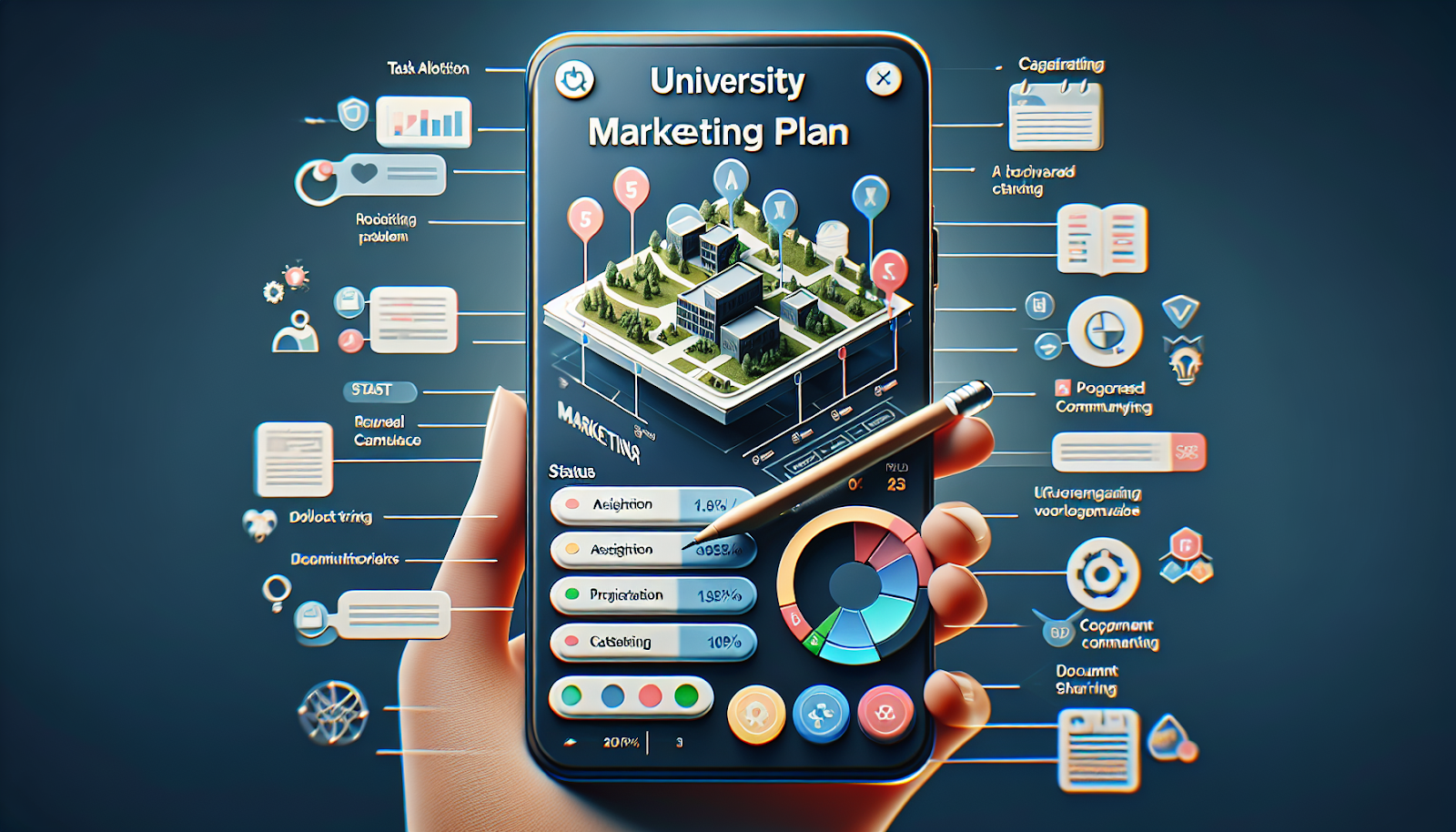
ClickUp offers a university marketing plan template designed to help those working in university marketing departments, giving a centralized platform to manage all tasks in an organized manner. This template is intended to streamline the process of allocating tasks, tracking progress, and improving accountability within teams.
Key Features
Centralized Workspace: The template acts as a one-stop workspace to handle multiple marketing tasks. You can organize tasks into categories and subcategories, improving clarity and accessibility.
Task Management: For every task, you can set timelines, assign individuals, set priority levels, and put tags for easy identification.
Status and Progress Tracking: This feature allows teams to keep track of the progress and status of tasks, ensuring effective and timely completion. There are different status options and color codes available.
Communication: Team members can leave comments under each task to communicate any updates or concerns, acting as a real-time communication tool.
Document Sharing: Documents related to the tasks can be shared and accessed by all team members.
The University Marketing Plan Template by ClickUp aims to improve productivity levels and ensure a smooth project management experience for university marketing teams.
Summary
ClickUp’s University Marketing Plan Template provides a versatile tool for university marketing teams to streamline their tasks. It offers features like a centralized workspace, task management provisions, status, and progress tracking, real-time communication, and document sharing. It increases efficiency and boosts productivity levels.
https://clickup.com/templates/marketing-plan/university
centralized workspace, task management📅, progress tracking📈, communication🗣️ & document sharing📄. Boosts teamwork! #ClickUp #MarketingPlanTemplate🎓✅
Tweet
Higher Education Marketing Plan Release
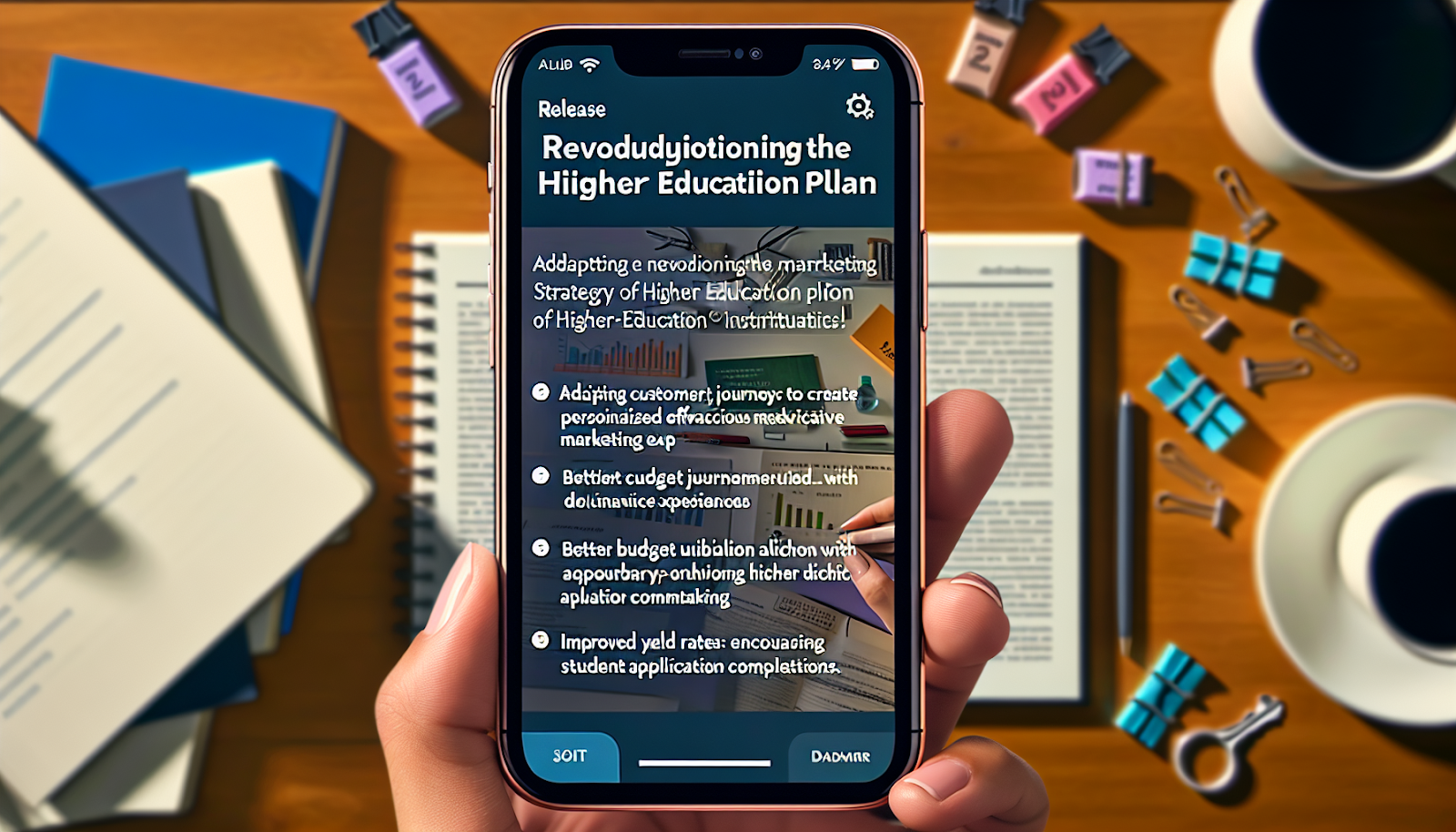
The webpage discusses the release of a higher education marketing plan by Release, a company specializing in meeting the marketing needs of higher education institutions.
About Release
Release is a marketing agency that aims at modernizing the marketing approach of higher education institutions.
Its new higher education marketing plan focuses on adapted customer journeys, better budget utilization, and improved yield rates.
Release Higher Education Marketing Plan
The marketing plan consists of three main components:
Adapting Customer Journeys: This approach aims to connect with prospective students more effectively. It includes personalized, segmented marketing approaches across different channels, tracking prospective students’ engagement, and understanding their needs.
Better Budget Utilization: Release’s plan emphasizes making the best use of limited marketing budgets common in higher education institutions. It proposes better tracking of marketing campaign results and making data-driven decisions.
Improved Yield Rates: To improve yield rates, Release’s marketing plan encourages methods that ensure more applicants complete their applications and enroll.
Commentary by Release Officials
Release’s officials highlighted the need for a more modern approach to higher education marketing.
They also stressed the importance of transparency in marketing efforts and better understanding students’ needs, which is central to their marketing plan.
Takeaways
Release’s new higher education marketing plan addresses the unique challenges and needs of higher education institutions. It emphasizes a more personalized, better budgeted, and results-driven approach appealing to modern prospective students’ sensibilities and behaviors. It can also potentially improve the yield rate of student applications. By aligning with the admired transparency and accountability principles in higher education, this plan targets greater efficacy in institutional marketing efforts.
https://heprofessional.co.uk/edition/release-higher-education-marketing-plan-release
Release’s new plan modernizes #HigherEd marketing with adaptive student journeys, maximized budgets & improved yield rates 📚🎓 #EducationMarketing
Tweet
Timing Your Enrollment Marketing Plan Campaigns

This blog post by Sonority Group provides information and advice on how to properly time your enrollment marketing plan campaigns to yield the best results. The piece argues that one of the main factors of a campaign’s success is the timing, which should be in tandem with your audience’s preferences and habits.
Background
No specific background resources are cited in the article.
Unique Positions
The piece emphasizes that there’s no one-size-fits-all approach when it comes to timing marketing campaigns – it ultimately depends on the specific audience, their online presence, and their behaviors. However, some general guidelines can help in devising a well-planned strategy.
Key Points
The author generates several important arguments and tips:
Understanding the Audience: It’s pertinent to know when your target audience is most likely to be active online. This often varies based on factors like the industry, type of audience, and the platform being used for the campaign.
Goal Definition: Clear objectives for the campaign should be defined. Whether it’s raising awareness, generating leads, or driving sales conversions, timing should echo these goals.
Campaign Testing: Testing the timing of the transition ads could be useful. Running A/B tests with different sending times can help find out when the audience is most responsive.
Relevance: Considering the relevance of the campaign material to the time of the year or a specific occasion could be beneficial.
Other influencing factors include: Holidays, Day of the week, Time of the day, Seasonal trends, Industry events, Timing of complementary campaigns, Current events, and other external factors.
Summary and Takeaways
Timing is a critical factor when it comes to the success of an enrollment marketing plan. Understanding target audience behavior, clearly defining objectives, performing tests, and considering the relevance of the campaign at different times of the year can go a long way towards optimizing campaign effectiveness.
Equipped with these insights, marketers should be able to better align their campaigns to maximize engagement and meet their objectives. Every detail counts in capturing the attention of your target audience, where the ‘when’ of distributing your content could be just as impactful as the ‘what’ and ‘how’.
https://www.sonoritygroup.com/blog/enrollment-marketing-plan-timing-your-campaigns
Effective timing = successful campaigns! Know your audience, set goals, A/B test & monitor relevance. Happy marketing! 🕒💼🎯 #EnrollmentMarketing
Tweet
Ultimate Higher Ed Marketing Plan
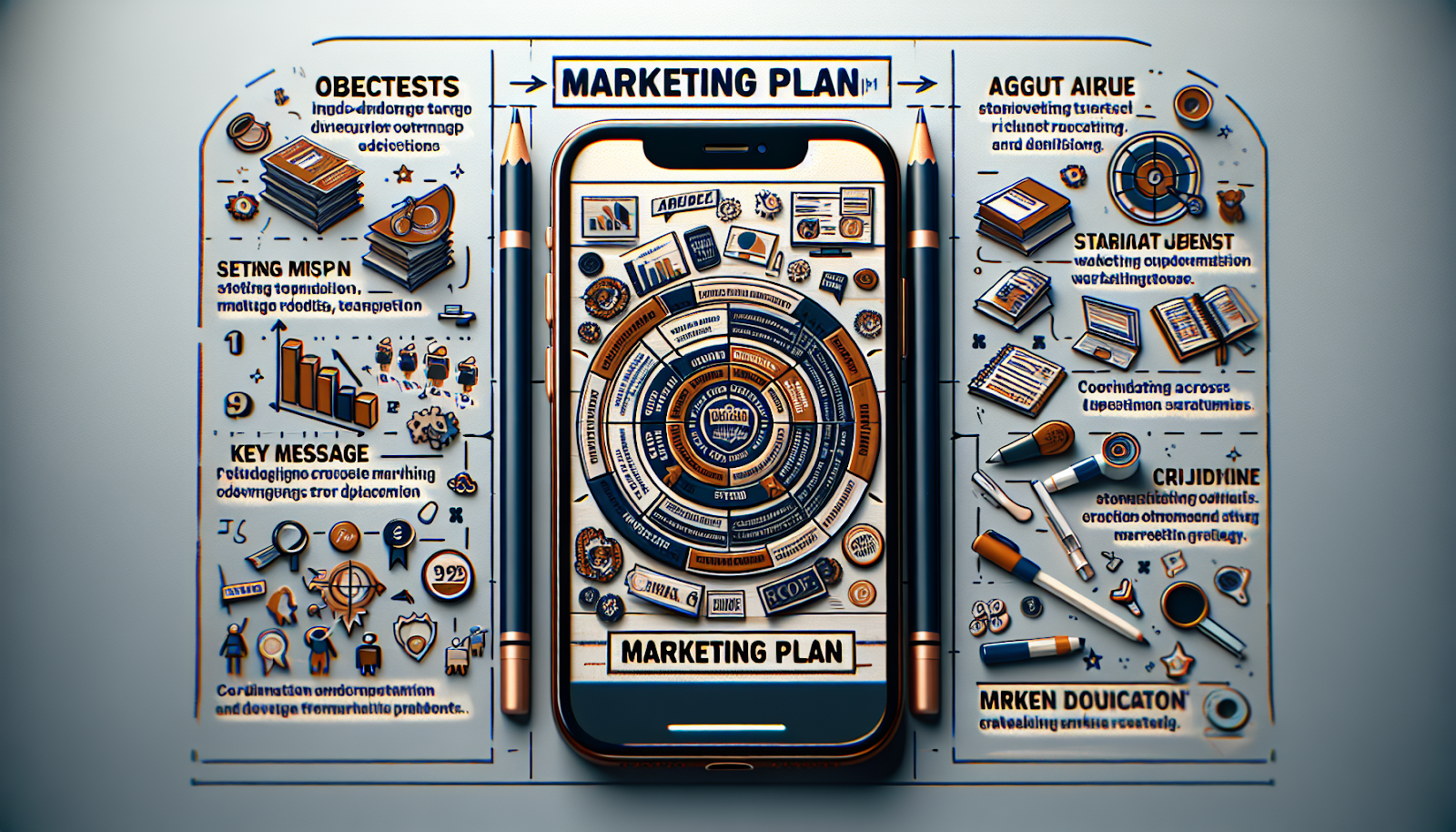
This document is a guide for college marketing teams to develop and implement an effective marketing plan. It outlines the core elements of a higher education marketing plan, a step-by-step process to create one, and some practical tips to help colleges stand out.
Core Elements of a Higher-Ed Marketing Plan
Strategic Objectives: Identifying what the marketing plan aims to achieve.
Target Audiences: Defining the demographic profiles of the students the school wants to attract.
Brand Positioning: Understanding how the school’s brand fits within the higher education sector.
Key Messages: Determining what messages to spread to potential students.
Marketing Channel Strategy: Selecting which platforms to use for marketing, such as websites, social media, or traditional media.
Steps to Develop a Marketing Plan
Set Objectives: Determine what the marketing campaign wants to accomplish.
Identify Target Audience: Identify the demographic profiles of potential students.
Define Brand Positioning: Understand how the school is unique compared to other schools.
Create Key messages: Decide what messages to share with potential students.
Select Marketing Channels: Choose the best platforms to reach the target audience.
Tips to Stand Out
Make Data-Driven Decisions: The marketing plan should rely on college data and market research to align activities with the institutions’ strategic goals.
Coordinate Across Departments: Synergies across different departments can help to deliver a consistent brand image and help capture prospective students’ interest.
Leverage Social Media: It’s an effective way to reach today’s tech-savvy students, and provide a sense of campus life via posts and stories.
Gather Feedback: Gather information from prospective students and use feedback to improve and tweak the marketing approach.
Conclusion
The document emphasizes the importance of a solid marketing plan for higher-ed institutions trying to attract and retain students. Strategic marketing, guided by research and data, can help institutions to stand out in a highly competitive field. By focusing on defined goals and being able to adapt to feedback and change, higher-ed institutions can improve their visibility and relevance to potential students.
Source Information
The document does not cite any sources.
Develop a top higher-ed marketing plan: objectives, target audiences, brand, key messages, & channel strategy. Make your college stand out! 🎓🚀 #HigherEdMarketing #CollegeMarketing
Tweet
How to Develop a Successful Education Marketing Plan
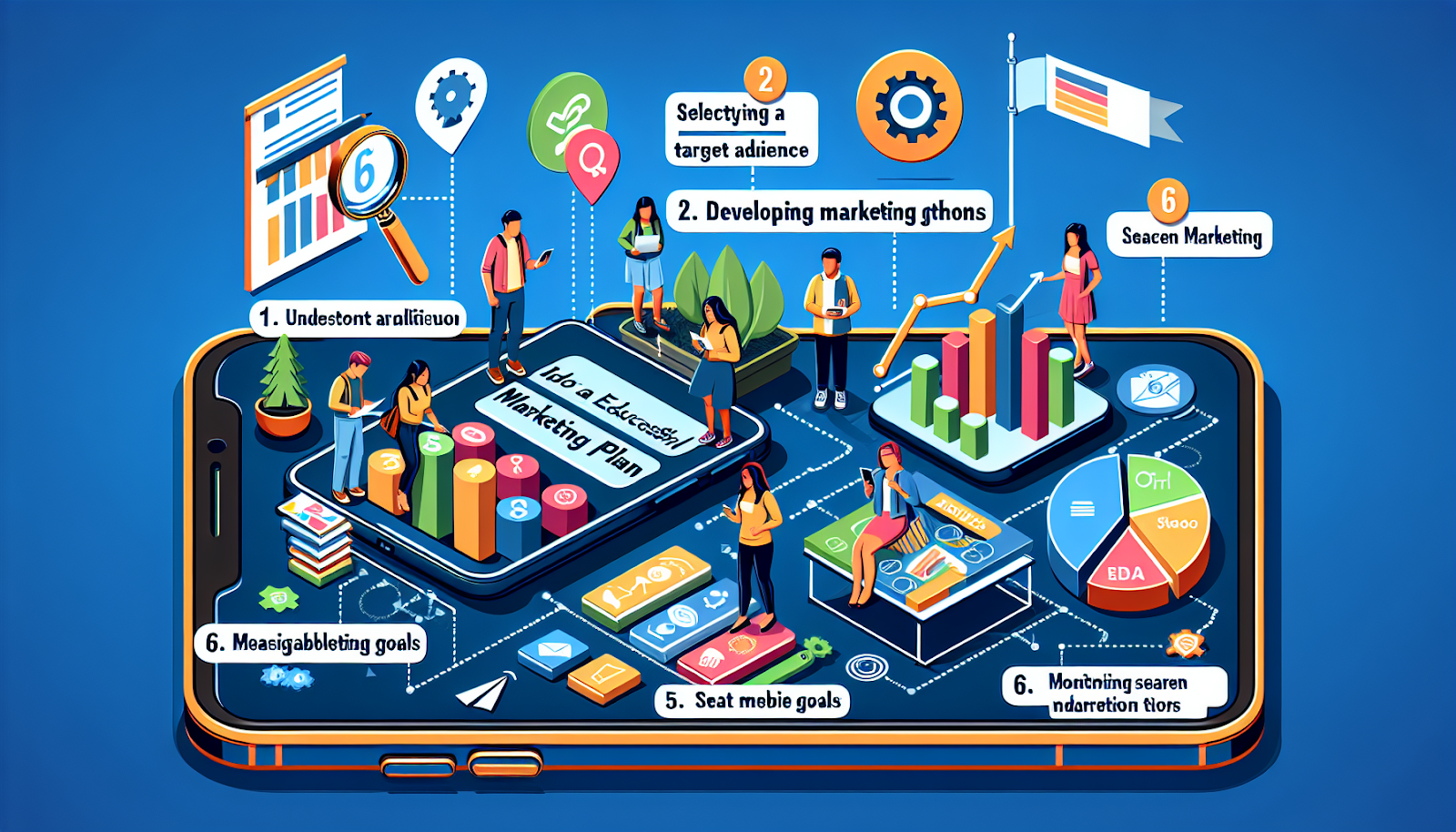
This Ubrik blog post discusses how to create an effective marketing plan for an educational institution. The author stresses that planning is a component for a successful marketing strategy in a highly competitive educational sector.
The post mentions six steps for developing an effective education marketing plan that are discussed in detail.
1. Understand your target audience
Understanding who your potential students are, what they want, and how to reach them is an important aspect of any marketing plan. This involves carrying out extensive market research.
2. Select key marketing channels
After understanding your audience, the next step is selecting the appropriate marketing channels to reach out to your target audience.
3. Set measurable marketing goals
Establish measurable objectives that align with the institution’s business goals. Measurable goals are essential for tracking progress and determining the success of a marketing plan.
4. Develop a content marketing strategy
The author advises that a successful marketing plan incorporates a solid content marketing strategy with compelling and engaging content.
5. Implement Search Engine Optimization (SEO)
SEO helps in increasing the visibility of the institution’s content online.
6. Monitor and adjust your plan
The world of digital marketing is dynamic and as such, it’s important to regularly monitor and adjust the marketing plan as per the changing dynamics of the market.
The article mentions a few tools to consider for the development and execution of an effective education marketing plan:
Using data analysis tools like Google Analytics to gather data on your website’s traffic and to monitor the success of your marketing campaigns.
Utilizing Social Media channels, Email marketing software, and CRM platforms for communication and to specifically target segments of your audience.
Content creation and management tools such as Canva or SEMrush for creating and managing marketing content.
Key Takeaways
Understanding your target audience, selecting key marketing channels, setting measurable goals, developing a robust content strategy, implementing SEO, and regularly monitoring and adjusting the plan are essential steps in developing a successful education marketing plan.
Utilizing various digital tools, ranging from data analysis tools to content creation and management platforms, can aid in the successful execution of an effective education marketing plan.
The post does not cite any external resources for further reading.
https://blog.ubrik.com/how-develop-a-successful-education-marketing-plan
Master education marketing: Know your audience, choose channels, set goals, create content, use SEO, monitor & adjust. Leverage digital tools! 🎯📚 #EducationMarketing #DigitalStrategy
Tweet
Private University Marketing Plan Template Overview
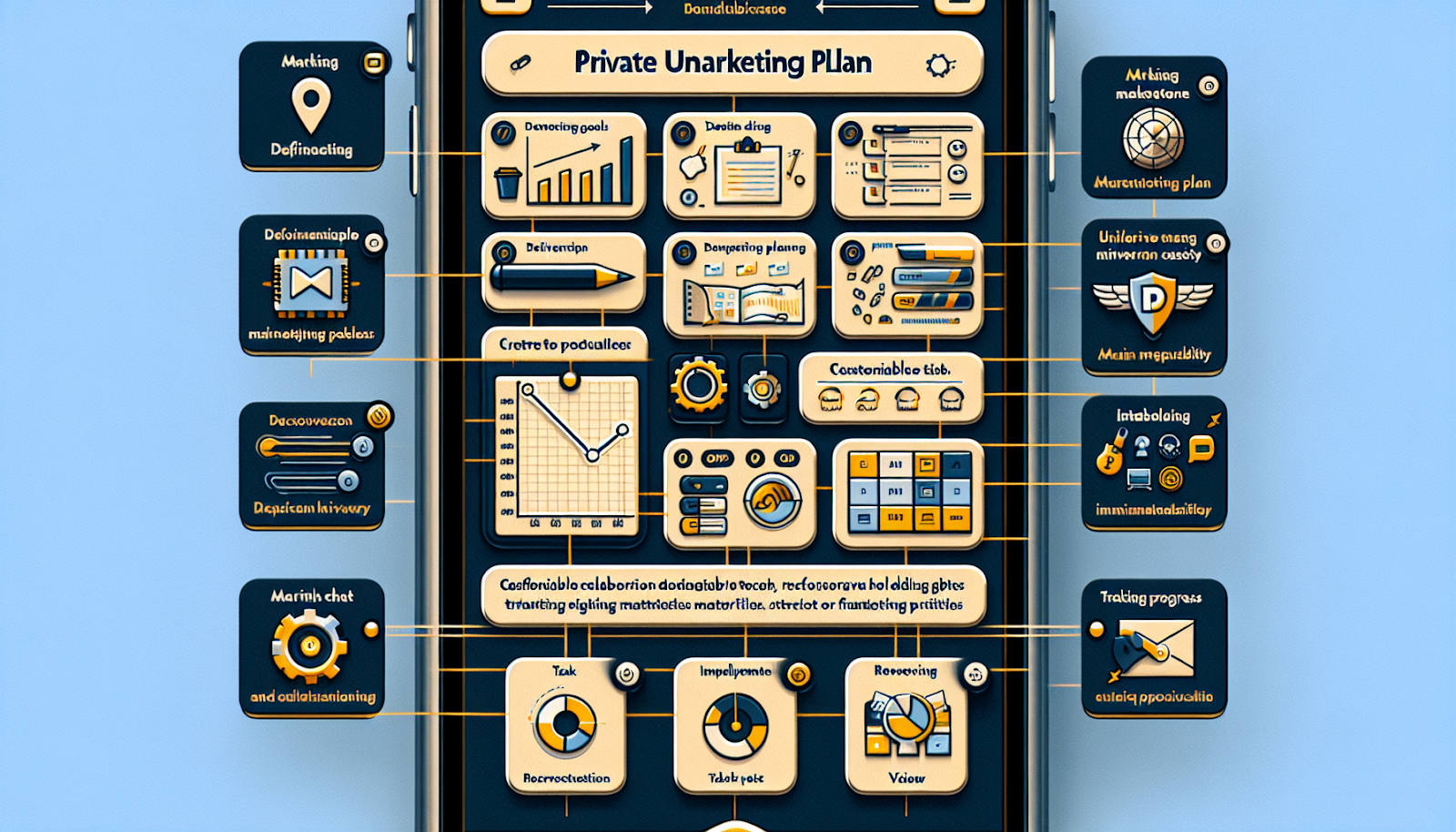
ClickUp offers a free-to-use Private University Marketing Plan Template for marketing teams within educational institutions. The template aims to streamline marketing processes in order to increase university visibility and recruit potential students.
Key Features
Customizable tags to categorize university marketing tasks.
Document repository for maintaining centralized marketing material.
Task-list feature for following up with assigned responsibilities.
Integrated Gantt view to track progress on various marketing activities.
Benefits
Improved collaboration through shared resources and clear communication.
Efficient management of resources due to the centralized information.
Increased productivity provided by the ability to monitor task progress.
The possibility of meeting marketing goals within specific timelines.
How to Use
Define marketing goals: Specify what you aim to achieve with the university’s marketing efforts.
Create a marketing plan: Employ the ClickUp template to generate a detailed plan of action.
Implement the marketing plan: Execute the tasks specified in the marketing plan using the templates provided by ClickUp.
Track Progress: Use Gantt view function to keep an eye on progress towards marketing objectives.
Review: Conduct periodic reviews to determine progress and make necessary adjustments.
Summary
The Private University Marketing Plan Template by ClickUp is a useful tool for managing and executing marketing initiatives in educational institutions.
Their platform offers a customizable and centralizes experience that can improve collaboration, optimize resources, and increase productivity.
By defining goals, creating and implementing plans, tracking progress, and conducting reviews, universities can meet their marketing objectives more effectively.
https://clickup.com/templates/marketing-plan/private-university
Use ClickUp’s free Private University Marketing Plan Template 🎓 to boost visibility, collaboration & reach marketing goals. #EduMarketing #ClickUp
Tweet
5 Easy Steps to a Marketing Strategic Plan
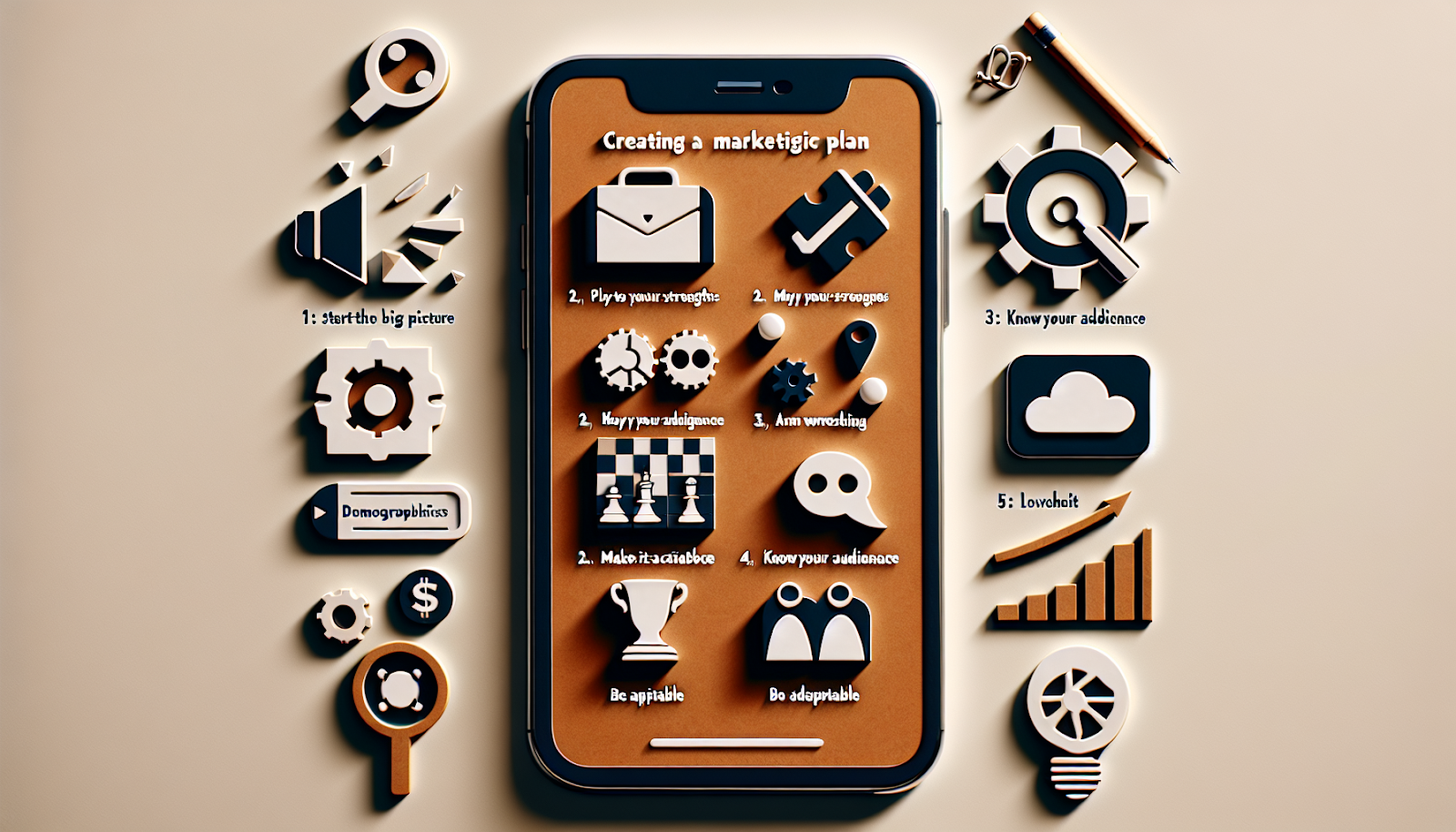
This webpage is a blog post from 5 Degrees Branding which provides a guide on how to create a marketing strategic plan in 5 simple steps: 1) Start with the big picture, 2) Play to your strengths, 3) Know your audience, 4) Make it actionable, and 5) Be adaptable.
Start with the Big Picture
The first step to creating a marketing strategic plan is to start with a clear objective or goal. This goal can stem from the company’s mission statement, a vision, or a measurable goal.
Thinking through the big picture will also require thinking about the target audience, understanding the brand, and developing strategies to make the brand stand out.
Play to Your Strengths
Understanding the business’s strengths or what sets it apart from competitors and leveraging those for the benefit of the brand is also important.
This can be done through a SWOT analysis to identify strengths, weaknesses, opportunities, and threats.
Know Your Audience
Identifying the target market is also a key step in developing a marketing strategic plan.
Steps for doing so include finding out who they are, how they behave, what they want or need, and understanding how best to communicate with them.
Make it Actionable
Once a comprehensive plan has been formulated, the next step is to make it actionable.
This means breaking down the steps into more manageable tasks, setting reasonable deadlines, and articulating the steps clearly to the team to achieve the goals set out in the plan.
Be Adaptable
The final step is to remain flexible and prepare for adjustments according to changes in the business environment.
Markets are dynamic and continually evolving. Therefore, being ready to adapt plans and strategies to fit changing situations or new developments within the market is a necessary step in any successful marketing strategic plan.
Background Resources
No background resources were cited in the webpage.
The unique position shown in this webpage is the emphasis on flexibility or the ability to adapt the plan when needed.
Summary and Takeaways
This blog post offers five steps to create a marketing strategic plan:
Begin with a clear objective
Identify the business’s unique strengths
Understand the target audience
Ensure the plan is actionable
Be prepared to adapt the plan to changes in the market.
These steps provide an easy and straightforward guide through the process of creating a marketing strategic plan. The article emphasizes the importance of adaptability, showing that being ready to adjust plans and strategies according to market changes is crucial.
https://5degreesbranding.com/blog-full/5-easy-steps-marketing-strategic-plan
Creating a marketing plan? Follow @5DegreesBranding’s 5 steps: 1) Define goal 2) Leverage strengths 3) Know audience 4) Make it actionable 5) Stay adaptable. 🎯✅🔄 #MarketingStrategy #BusinessTips
Tweet
